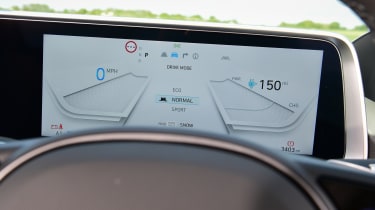Hyundai Ioniq 6 - Range, charging and running costs
The Hyundai Ioniq 6’s rapid charging tech means it’s surprisingly adept at long trips

Every Hyundai Ioniq 6 is fitted with a sizeable 77.4kWh battery and boasts impressive rapid-charging capabilities. However the electric saloon’s maximum driving range varies depending on whether you go for rear- or all-wheel drive.
The RWD version has an official range of 339 miles, while Hyundai says the AWD version can cover up to 323 miles before the battery is out of juice. Those figures are a long way off the 391-mile range of the updated Tesla Model 3 Long Range, or the 406 miles you can cover in Long Range Single Motor Polestar 2.
During our electric company car group test with five of the main rivals to the Ioniq 6, the Hyundai posted the most disappointing efficiency figure. Its efficiency was only 3.1 miles per kWh, which was even lower than the 3.2 miles per kWh we got from an identical Ioniq 6 AWD when tested against a BMW i4 eDrive40. Based on a useable capacity of 74kWh, the Ioniq 6 AWD is likely only to have 230 miles of range, so we’d recommend sticking with the rear-wheel drive version to get better range and efficiency numbers.
It’s not the most efficient, but the Ioniq 6 makes up for that with its highly impressive 800V charging tech that allows it to accept a peak charging rate of up to 220kW. In other words, if you plug the Ioniq 6 into a 350kW ultra-rapid charger, a 10 to 80 per cent top-up can take as little as 18 minutes. That’s about 10 minutes quicker than it would take a BMW i4 to do the same job. Fully recharging the Ioniq 6’s 77.4kWh battery will take around 11 hours if you use a more typical 7kW home wallbox charger.
Tax
The Ioniq 6 is particularly appealing to company car drivers because it sits in the lowest possible bracket for Benefit-in-Kind (BiK) tax. This is the same for all electric cars currently, so while it’s great if you’re coming from a petrol or diesel car, it’s not a unique selling point for the Hyundai if you’re only considering electric models as a company car.
For now, zero-emission cars, regardless of list price, are in the UK's free road tax (VED) band. That will change from 2025 onwards, when electric car will have to start paying road tax and the London Congestion Charge.
Insurance
Insurance premiums for electric cars are generally higher than for the equivalent petrol or diesel-powered model, partly because of their rapid acceleration and the high price of repairs. Battery packs, in particular, are costly to replace.
It’s the same story with the Ioniq 6. The cheapest model to insure will be the entry-level RWD model, which sits in group 36 (out of 50), while the AWD versions, which are quite a bit faster, sit in group 41.
The BMW i4 attracts similar insurance ratings (groups 35-43), while the recently updated Polestar 2 will cost a little more to insure, given that it lands in groups 40-44. However the Tesla Model 3 is worse still, in groups 48-50.
Check if your car needs an MoT and view its complete history with our MoT History Checker...
Depreciation
According to our latest data, the Ioniq 6 will hold onto between 48 and 53 per cent of its original list price after three years and 36,000 miles of ownership. In case you’re wondering, the Ultimate trim models with four-wheel drive are projected to retain the least value, while the entry-level Premium-spec cars lead the pack.
In comparison, the BMW i4 and Polestar 2 are expected to retain 50-55 and 41-49 per cent of their value, respectively.
To get an accurate valuation on a specific model check out our valuation tool...










